14th October 2012
It usually takes the warm glow of distant memory to assign any particular experience to one’s pantheon of top treasures, but I cannot imagine that today will ever slip out of my list of “best wildlife days ever”. It was simply wondrous. However, I should also point out that part of the reason it was special was in looking for wildlife that is fast disappearing, and that is never good.
Never mind, our day began with breakfast at Tonia Cochran’s own special treasure, her ranch of Inala where, in contrast, sadly, to many properties in Tasmania, wildlife is repected and encouraged. We soon embarked on a short walk to take in her garden birds, which constitute a pretty unique list.
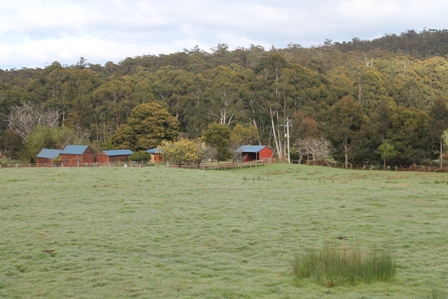
Inala, Tasmania, 14/10/12 (Dominic Couzens)
Among the delights enjoyed in a 45 minute stroll were Tasmania’s own Dusky Robin, both Strong-billed and Black-headed Honeyeaters and, most exciting of all, a pair of Forty-spotted Pardalotes toying with using a nesting box put up specially for them. The Pardalotes are pretty rare; besides being confined to Tasmania, there aren’t many outside Bruny and Maria Islands, and the total number of 1000-1500 individuals is found in an area of only 330 sq km. They are completely dependent on one species of tree, the white gum (Eucalyptus viminalis), on which the box was placed. In fact, two pairs were bickering in the canopy, which seemed a bit of a case of fiddling with trivial matters while their own personal Rome burns.
Most other days could have begun and ended with such a bird list and been more than satisfying, but we had a plane to catch at 10am to take us to Melaleuca, the only breeding home of the critically endangered Orange-bellied Parrot. It’s a forty-minute flight from the airstrip at Bruny Island, the latter of which hardly constitutes civilisation itself. You travel in a tiny, 10-seater Islander run by Par Par Avion Wilderness Tours, and to muffle the
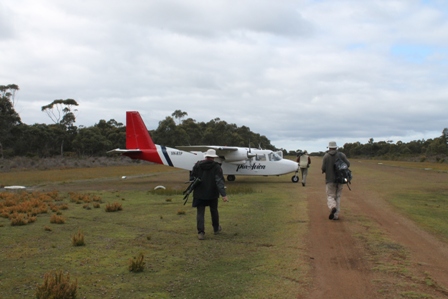
Rob, Mike and Tim prepare to board the flight to Melaleuca, Tasmania, 14/10/12
sound of the engine you put on headphones and can hear the pilot speaking on his radio, saying such reassuring things as “bank of rain ahead, I’m going out to sea to try going around The Friars (rocks)”. It’s a bit of a white knuckle ride, which simply adds to the thrill of visiting the South-west National Park, one of the world’s true wilderness areas. The landing strip at Melaleuca is in a place that is about 55km from the
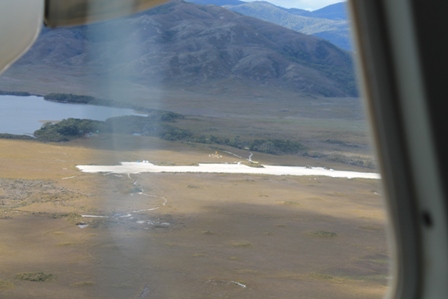
Melaleuca Airstrip, 14/10/12 (Dominic Couzens)
nearest road, or a six-day hike if you prefer. It looks, and is, remote, and is the dramatic backdrop to one of the world’s most pressing wildlife emergencies.
The airstrip is located in the midst of the damp moorland/forest edge habitat favoured by the Parrots. On the day that we visited, the weather was wild and windy, with frequent showers of rain, giving the landscape a curiously Scottish feel,
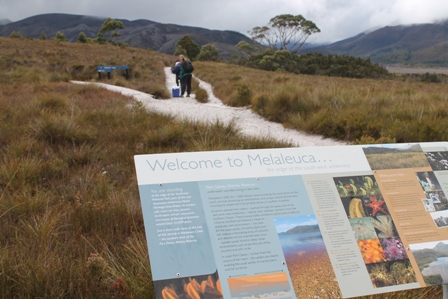
Melaleuca - we made it (Dominic Couzens)
aside from the sprinkling of obvious Eucalypts.
But where were the parrots that we had come to see? Tonia took us to the “old” bird hide and provided us with smoked salmon sandwiches and coffee (utter paradise in paradise), and didn’t seem particularly anxious about looking for the birds in the first 30 minutes of our three-hour stay. In fact, the hut and the nearby toilet block (surely one of the most remote in the world) constitute a good stake-out for a carnivorous marsupial called the Tiger Quoll (not seen by us) and a beautiful finch with a fiery-coloured rump which happens to be called the Beautiful Firetail.
Post-refreshments, tension rose a little since we had not yet seen the parrots. As we made our way towards the “new” birdwatchers’ lookout, I began to muse, as I trudged over the puddle-bespattered trail, on the possibility of missing the OBP on my one-and-only chance to see it, and how it would feel to fly back having failed. The thoughts were still warm when there was a shrill, slightly buzzy call from overhead and the distinct shape of a very small, slim parrot appeared unmistakably, the bird dashing over towards a tall, isolated tree. Tonia announced “Orange-bellied Parrot” and, once it had been established that everyone had seen it, we raced over to where the bird (or two birds) had landed. The next few minutes were emotional, as we watched a pair of birds at their nest-hole. These two had just arrived back at Melaleuca from their wintering grounds along a coastal strip of
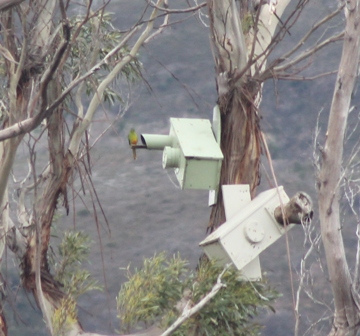
Orange-bellied Parrot, Melaleuca, Tasmania, 14/10/12 (Dominic Couzens)
South Australia (including the Coorong and formerly Victoria and New South Wales). They are thus unusual among Australian birds in having a regular north-south migration (many Oz birds are resident or simply nomadic), and this is part of their problem. While the breeding grounds are still suitable, on their wintering grounds these small parrots have suffered all sorts of mishaps, such as increasing urbanisation, overgrazing and agricultural change on their restricted saltmarsh and coastal habitat.
Mishap is actually a serious understatement, because after years of decline, the Orange-bellied Parrot population is now at a desperate level. Last season only 20 birds turned up in Melaleuca (9 this year as I write) – and that, folks, represents the TOTAL wild population. There are some in captivity, but what will happen to them if they are released? Will they be able to migrate and resume normal OBP life? And if they cannot, the species is diminished, if it isn’t finished off already. Miracles happen – a wild increase could occur – but at the moment, to borrow a phrase, the future isn’t bright if you’re orange.
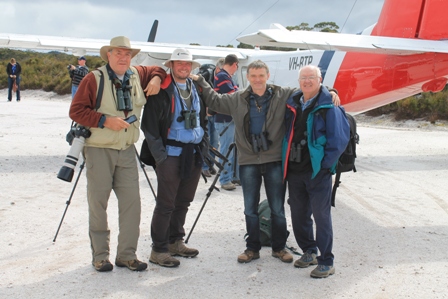
Part of Tassie Team at Melaleuca - from left Tim Appleton, Rob Jolliffe, Dominic Couzens, Ray Tipper (Mike Unwin)
But as mentioned earlier, there’s no shame in being delighted to see a rare bird, and no one in our party could possibly deny that they were seriously chuffed. Seeing the OBPs early (Tonia said that sometimes people have to wait for hours) allowed us to catch up with some other good stuff, including Southern Emu-Wren – a bewitching bird with odd plumes for its tail – and Striated Fieldwren, which looks like a Grasshopper Warbler’s much richer and better dressed brother. On the flight back, I looked down and managed to catch a glimpse of a Shy Albatross over the ocean. Somehow, to see this bird from a light plane gave it some extra kudos, as if it needed any more.
Returning to Bruny Island by 4pm meant that our day was far from over. A short walk near the airstrip enabled us to see three species of Cuckoo – Pallid, Fan-tailed and Shining Bronze, in about 20 minutes, and to hear a fourth, a Horsfield’s Bronze. Four cuckoos on any other day…you know the rest. I daren’t even mention later on spotting the magnificent white form of the Grey Goshawk near Inala, because I will stop believing it all myself.
It didn’t stop at nightfall, either, because Bruny Island also happens to be one of the best places in Tasmania for spotlighting mammals, and tonight was the night set aside for this. Now, the trouble with recounting this is that, if you aren’t a devotee of Australian mammals, you might find the names somewhat obscure. Suffice to say that, almost as soon as we had begun, Tonia called out:
“That’s amazing. A Long-nosed Potoroo!”
Shortly afterwards it was “Tasmanian Pademelon!” And the another and another. These creatures are similar to kangaroos and are closely related to these and wallabies, but are more compact, with a smaller head.
The biggest thrill was later, on North Bruny, when at last, having pored over their picture for a number of years, I was delighted when the van headlights illuminated a mammal I had long wanted to see: “Eastern Quoll!” Quolls are just terrific; they are carnivorous marsupials, a bit larger than a Stoat, and they have dark brown fur dotted with white spots. After half an hour or so, we notched up 11 sightings of these animals, including quite a number of youngsters on early foraging trips following their expulsion from their mother’s care.
Close to midnight we nearly ran over a Fairy Penguin, and then it was over.
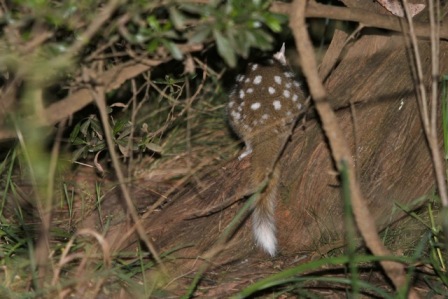
Eastern Quoll, Bruny Island, Tasmania, 14/10/12 (Mike Unwin)
